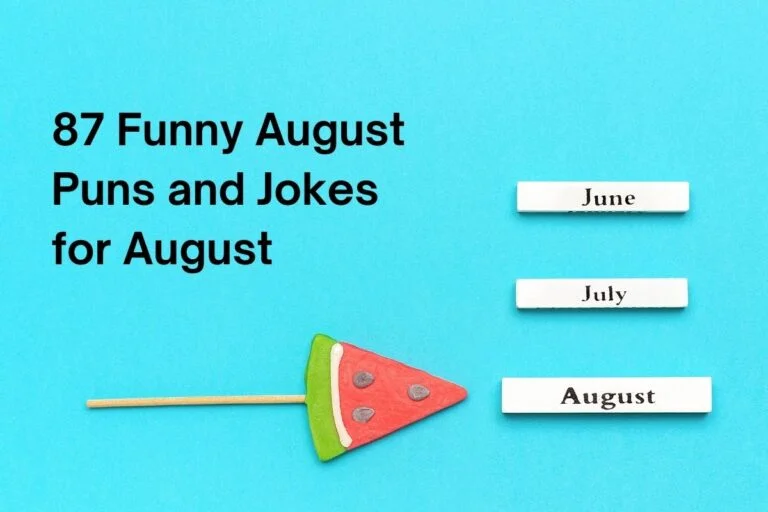How to Make Puns in 5 Simple Steps (With Practical Examples)

Creating puns is a fun and creative way to play with language.
After all, puns can add humor to your conversations, writing, and even professional presentations.
But what exactly goes into making a good pun?
This guide will break down the process, providing practical examples to help you make unique and impactful puns.
Understanding Puns & Their Types
Before diving into the creation of puns, it’s important to understand what puns are and how they work.
Puns are a form of wordplay that exploits the multiple meanings of a term or similar-sounding words for humorous or rhetorical effect.
There are several types of puns, each with its unique characteristics.
Homophonic Puns
Homophonic puns play on words that sound alike but have different meanings. These puns rely on the phonetic similarity between words or phrases.
For instance, take the classic: “I used to be a baker, but I couldn’t make enough dough.”
Here, “dough” refers to both money and the mixture used in baking. The humor arises from the unexpected shift in meaning, which catches the listener off guard.
Homophonic puns can be particularly tricky because they depend on the precise sounds of words.
Dialects and accents can affect how a pun is received, making it either more or less effective.
For instance, a pun that works in British English might fall flat in American English due to differences in pronunciation.
Homographic Puns
Homographic puns, on the other hand, play on words that are spelled the same but have different meanings. These puns are all about visual similarity rather than sound.
For example, “A boiled egg every morning is hard to beat.” The word “beat” can mean to mix thoroughly or to surpass, making this pun both clever and versatile.
Homographic puns are visually dependent, meaning they can be particularly effective in written form.
They engage the reader’s ability to see and interpret different meanings from the same spelling, adding a layer of depth to the pun.
In literature, homographic puns can create dual meanings that enrich the text and provide additional layers of interpretation.
Check Out: 160 Puns About Puns That Are Pun of a Kind
Compound Puns
Compound puns involve multiple puns within a single sentence, creating a layered effect. They are like the inception of the pun world, adding depth and complexity.
An example is: “When the electricity went out, the students were de-lighted.” Here, “de-lighted” plays on both the loss of light and the students’ delight at not having to study.
Crafting a good compound pun requires careful thought and creativity. It’s about weaving multiple layers of meaning together in a way that is both coherent and surprising.
Compound puns often work best in contexts where the audience can appreciate the intricacy and cleverness of the wordplay.
Visual Puns
Visual puns rely on images or graphics to convey the pun. These are especially popular in advertising and memes, where a picture can enhance the wordplay.
For instance, a picture of a clock with wings captioned “Time flies” is a simple yet effective visual pun that combines imagery with a play on words.
Visual puns blend art and language, creating a powerful tool for communication. They can transcend language barriers since the visual component is universally understandable.
In advertising, visual puns can make a message more engaging and memorable, leveraging the power of imagery to amplify the impact of the pun.
5 Steps to Create A Great Pun
Creating a pun involves several steps, from brainstorming ideas to refining the wording. Here’s a detailed guide to help you craft your own puns.
1. Choose Your Words
The first step is always to start by selecting a word or phrase that you want to play with. It can be related to the topic you’re discussing or something completely random.
The key is to find words with multiple meanings or words that sound similar to others.
Example: Let’s choose the word “bark.” It can mean the sound a dog makes or the outer covering of a tree.
Choosing the right word is crucial. It’s about finding a term that has the potential for dual meanings or phonetic similarity.
Consider words that are commonly used in different contexts or have well-known homophones. This step sets the foundation for your pun and determines how effective and humorous it will be.
Check Out: History of Puns from 4,000 BCE to The Middle Ages & 21st Century
2. Brainstorm Multiple Meanings
Next, think about the different meanings of your chosen word. Write down all the possible interpretations and related words.
Example: For “bark,” the meanings include:
– A dog’s sound
– Tree covering
– A type of sailing ship
Brainstorming is a creative process. Don’t limit yourself to obvious meanings. Think broadly and explore less common uses of the word.
This step involves a mix of creativity and linguistic knowledge. The more meanings you can come up with, the richer your potential puns will be.
3. Create a Context
Now, create a context or scenario where your word can be used in a way that highlights its multiple meanings. This is where your creativity comes into play.
Example: Consider a situation where someone is both talking about their dog and gardening.
The context is the stage for your pun. It sets up the scenario where the wordplay will occur. A well-crafted context makes the pun feel natural and relevant rather than forced.
Think about situations or narratives that can seamlessly incorporate the dual meanings of your chosen word.
4. Construct the Sentence
Construct a sentence that brings out the pun. Ensure that the sentence is clear and that the wordplay is obvious.
The humor often comes from the surprise or twist in meaning.
Example: “My dog was so loud I had to tell him to bark up the right tree.”
This step is about execution. Your sentence should flow naturally and lead the audience to the pun without being too obvious.
The key is to balance clarity and subtlety, ensuring the pun is both understandable and surprising. Pay attention to the structure and wording to make the pun as effective as possible.
5. Refine and Test
Finally, refine your sentence to make sure it flows well and test it on someone. Sometimes, a little tweaking is needed to make the pun as effective as possible.
Example: “My dog was barking so much in the garden, I told him to bark up the right tree.”
Refinement involves editing and polishing. This might mean adjusting the wording, changing the context slightly, or adding extra elements to enhance the pun.
Testing your puns on others can provide valuable feedback. What works for you might not work for everyone, so getting a second opinion can help you fine-tune your wordplay.
Practical Examples
Now, let’s look at some practical examples to see how these steps come together in creating effective puns.
Example 1: Food-Related Pun
1. Choose Your Word: Cheese
2. Brainstorm Multiple Meanings:
– Dairy product
– To smile (say cheese)
– Something cheesy (corny)
3. Create a Context: Talking about a photo and a meal.
4. Construct the Sentence: “I couldn’t smile for the photo; my cheese was too cheesy.”
5. Refine and Test: “I couldn’t smile for the photo; the cheese was just too cheesy.”
In this example, the pun plays on the dual meaning of “cheese” as both a dairy product and a term used when taking photos.
The humor comes from the twist in context, where the cheese’s taste affects the ability to smile for a photo. The refinement step ensures the sentence flows naturally and the pun is clear.
Example 2: Technology-Related Pun
1. Choose Your Words: Byte
2. Brainstorm Multiple Meanings:
– Unit of digital information
– Bite (to eat)
3. Create a Context: Talking about eating and working on a computer.
4. Construct the Sentence: “I wanted to take a byte of my sandwich while fixing the computer.”
5. Refine and Test: “I took a byte out of my sandwich while working on the computer.”
This pun uses the homophonic similarity between “byte” (digital information) and “bite” (to eat).
The context of eating while working on a computer makes the wordplay relevant and humorous. Refining the sentence ensures it is concise and the pun is easily understood.
Check Out: Puns in Literature: From Plautus to Shakespeare to James Joyce
5 Tips for Creating Effective Puns
While the basic steps to creating puns are straightforward, making them effective and humorous can take practice. Here are some tips to enhance your pun-making skills:
1. Keep It Simple
Effective puns are usually simple and easy to understand. Avoid overly complicated wordplay that might confuse your audience. The humor should be immediate and clear.
Simplicity is key to a good pun. The best puns are those that can be grasped quickly and don’t require extensive explanation.
Focus on clear, concise wording that makes the pun obvious and impactful. Overcomplicating the wordplay can dilute the humor and make the pun less effective.
2. Play With Common Phrases
Using common phrases or idioms can make your puns more relatable and easier to understand. Modifying a familiar saying can create a clever twist.
Example: “Time flies like an arrow; fruit flies like a banana.”
Common phrases are familiar to most people, making them an excellent basis for puns. By tweaking these phrases, you can create puns that are both clever and easily understood.
The familiarity of the phrase adds to the humor, as the audience recognizes the original and appreciates the twist.
3. Use Visual Aids
Incorporate visual elements when possible, especially for visual puns. Images, memes, or even simple drawings can enhance the impact of your wordplay.
Example: A picture of a cow saying “Moo-ve over” in a crowd.
Visual puns blend language and imagery, creating a powerful tool for communication. They can be especially effective in advertising and social media, where images play a crucial role.
Visual aids can make your puns more engaging and memorable, as they appeal to both the visual and linguistic senses.
4. Know Your Audience
Tailor your puns to your audience’s interests and level of understanding. What works for a group of friends might not be as effective in a professional setting. Adjust your humor accordingly.
Understanding your audience is crucial for effective pun-making. Consider their interests, background, and context.
A pun that’s perfect for a casual conversation might not be appropriate for a formal presentation. Tailoring your puns ensures they are well-received and appreciated by your audience.
5. Practice Regularly
Like any skill, pun-making improves with practice. Challenge yourself to come up with puns daily, and pay attention to feedback. The more you practice, the more intuitive it will become.
Practice is essential for honing your pun-making skills. The more you play with words, the better you’ll become at spotting opportunities for puns.
Try setting aside time each day to brainstorm and create puns. Over time, you’ll develop a sharper linguistic intuition and greater creativity.
The Science Behind Puns
Interestingly, there’s a cognitive aspect to why puns work and why we find them amusing.
Puns engage the brain’s language centers and require a quick mental shift to understand the multiple meanings. This mental gymnastics is part of what makes puns enjoyable.
Cognitive Flexibility
Understanding puns requires cognitive flexibility, the ability to switch between different concepts and meanings. This mental agility is why puns can be both challenging and satisfying to understand.
Cognitive flexibility allows us to shift our thinking and see the dual meanings in puns. This mental exercise can be stimulating and rewarding, providing a sense of satisfaction when we grasp the pun. It also keeps our brains sharp, as it requires quick thinking and adaptability.
Humor and the Brain
When we understand a pun, the brain releases dopamine, the “feel-good” neurotransmitter. This reaction is similar to the pleasure we get from solving a puzzle or understanding a joke, which explains why puns can make us laugh or smile.
The humor in puns comes from the surprise and twist in meaning. Our brains enjoy this unexpected shift, releasing dopamine and creating a pleasurable experience. This reaction makes puns a fun and enjoyable form of humor, providing a quick mental reward.
Social Bonding
Laughing at puns together can strengthen social bonds. Shared humor creates a sense of camaraderie and mutual understanding. This social aspect is why puns are often used in group settings to build rapport.
Shared laughter over a pun can bring people closer together, creating a sense of unity and connection.
Puns can serve as a form of social glue, helping to build relationships and foster a positive atmosphere. This social bonding aspect makes puns a valuable tool in both personal and professional interactions.
Final Thoughts
Puns are more than just clever wordplay—they are a versatile and powerful tool in communication.
Whether you’re looking to add humor to a conversation, make your writing more engaging, or create a memorable marketing slogan, puns can help you achieve your goal.
By understanding the different types of puns and practicing these tips on how to make puns, you can enhance your linguistic creativity and enjoy the playful side of language.
So go ahead, embrace the pun, and start playing with words. With practice and a bit of creativity, you’ll be making puns that are not only clever but also effective in capturing attention and sparking laughter. Happy punning!






